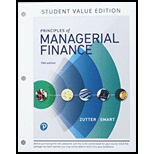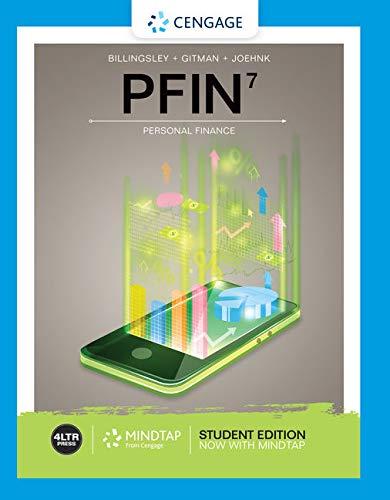
a)
To determine: Current earnings per share (EPS) and price earning ratio (P/E ratio).
Introduction:
Earnings per share refer to the earnings per share of outstanding shares of company’s common stock.
Price earnings ratio is determined by dividing the market price by the earnings per share.
b)
To determine: Shares repurchased
Introduction:
Earnings per share refer to the earnings per share of outstanding shares of company’s common stock.
Price earnings ratio is determined by dividing the market price by the earnings per share.
c)
To determine: The EPS after shares repurchased
Introduction:
Earnings per share refer to the earnings per share of outstanding shares of company’s common stock.
Price earnings ratio is determined by dividing the market price by the earnings per share
d)
To determine: The market price after the stock repurchase
Introduction:
Earnings per share refer to the earnings per share of outstanding shares of company’s common stock.
Price earnings ratio is determined by dividing the market price by the earnings per share
e)
To discuss: EPS before and after the proposed repurchase
Introduction:
Earnings per share refer to the earnings per share of outstanding shares of company’s common stock.
Price earnings ratio is determined by dividing the market price by the earnings per share
d)
To discuss: The stock holders’ position under repurchase and dividend.
Want to see the full answer?
Check out a sample textbook solution
Chapter 14 Solutions
Principles of Managerial Finance, Student Value Edition (15th Edition) (The Pearson Series in Finance)
- Which of the following financial instruments is used to hedge against interest rate risk? A) Futures contracts B) Treasury bills C) Interest rate swaps D) Corporate bondsarrow_forwardNeed assistance! Which of the following is the best description of a dividend? A) The amount a company spends on research and development B) A payment made to shareholders from company profits C) The price of a company’s stock D) The cost of producing goods for salearrow_forwardI need help in this question! Which of the following is the best description of a dividend? A) The amount a company spends on research and development B) A payment made to shareholders from company profits C) The price of a company’s stock D) The cost of producing goods for salearrow_forward
- No AI Which of the following is the best description of a dividend? A) The amount a company spends on research and development B) A payment made to shareholders from company profits C) The price of a company’s stock D) The cost of producing goods for saleNeed help!arrow_forwardDo not use ChatGPT! Which of the following is the best description of a dividend? A) The amount a company spends on research and development B) A payment made to shareholders from company profits C) The price of a company’s stock D) The cost of producing goods for salearrow_forwardDo not use AI No chatgpt The concept of risk-return tradeoff implies that: A) Investors expect higher returns for taking on more risk B) Risk is irrelevant to investment decisions C) Low-risk investments always produce high returns D) Diversification eliminates all riskarrow_forward
- No chatgpt The concept of risk-return tradeoff implies that: A) Investors expect higher returns for taking on more risk B) Risk is irrelevant to investment decisions C) Low-risk investments always produce high returns D) Diversification eliminates all riskarrow_forwardI need help completing a chart with the following base on Amazonarrow_forwardWhat is the primary purpose of financial management? A) Maximizing profits B) Minimizing costs C) Maximizing shareholder wealth D) Managing liquidity need help!arrow_forward
- What is the primary purpose of financial management? A) Maximizing profits B) Minimizing costs C) Maximizing shareholder wealth D) Managing liquidityarrow_forwardThe time value of money concept assumes that: A) A dollar today is worth more than a dollar tomorrow B) A dollar tomorrow is worth more than a dollar today C) Money has no time value D) Money grows at a fixed interest rate need answer.arrow_forwardThe time value of money concept assumes that: A) A dollar today is worth more than a dollar tomorrow B) A dollar tomorrow is worth more than a dollar today C) Money has no time value D) Money grows at a fixed interest ratearrow_forward
 EBK CONTEMPORARY FINANCIAL MANAGEMENTFinanceISBN:9781337514835Author:MOYERPublisher:CENGAGE LEARNING - CONSIGNMENT
EBK CONTEMPORARY FINANCIAL MANAGEMENTFinanceISBN:9781337514835Author:MOYERPublisher:CENGAGE LEARNING - CONSIGNMENT Pfin (with Mindtap, 1 Term Printed Access Card) (...FinanceISBN:9780357033609Author:Randall Billingsley, Lawrence J. Gitman, Michael D. JoehnkPublisher:Cengage Learning
Pfin (with Mindtap, 1 Term Printed Access Card) (...FinanceISBN:9780357033609Author:Randall Billingsley, Lawrence J. Gitman, Michael D. JoehnkPublisher:Cengage Learning Intermediate Financial Management (MindTap Course...FinanceISBN:9781337395083Author:Eugene F. Brigham, Phillip R. DavesPublisher:Cengage Learning
Intermediate Financial Management (MindTap Course...FinanceISBN:9781337395083Author:Eugene F. Brigham, Phillip R. DavesPublisher:Cengage Learning




